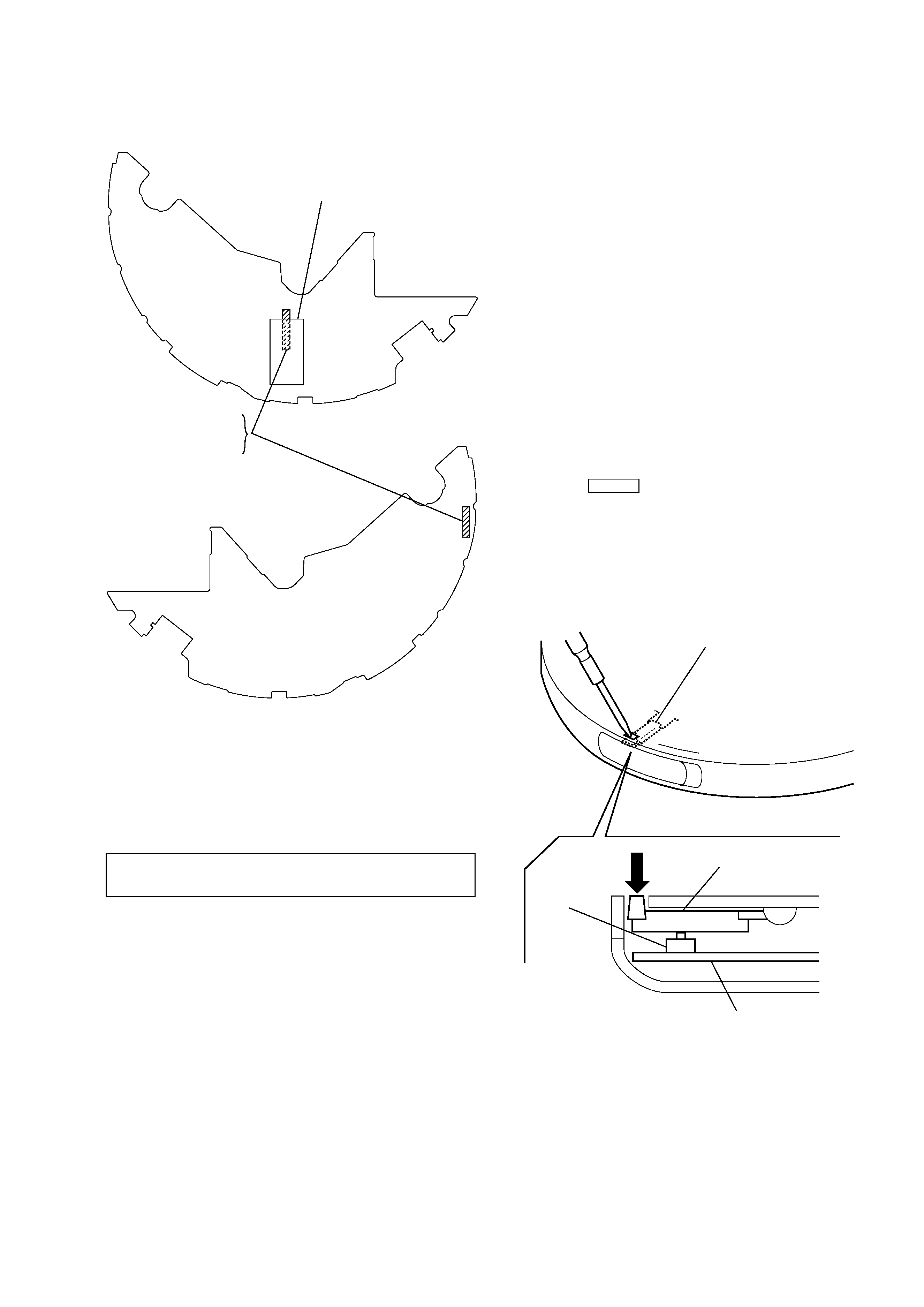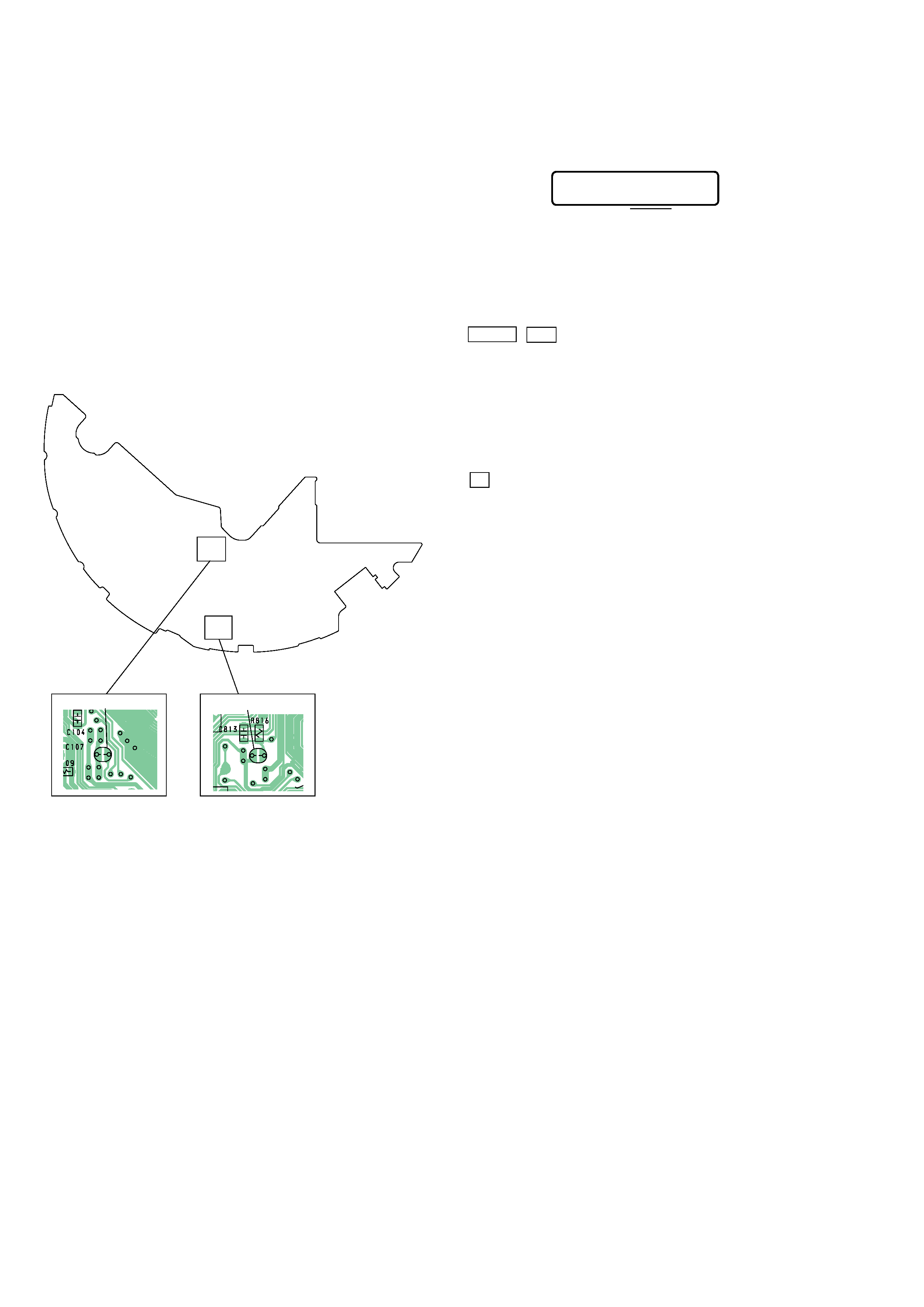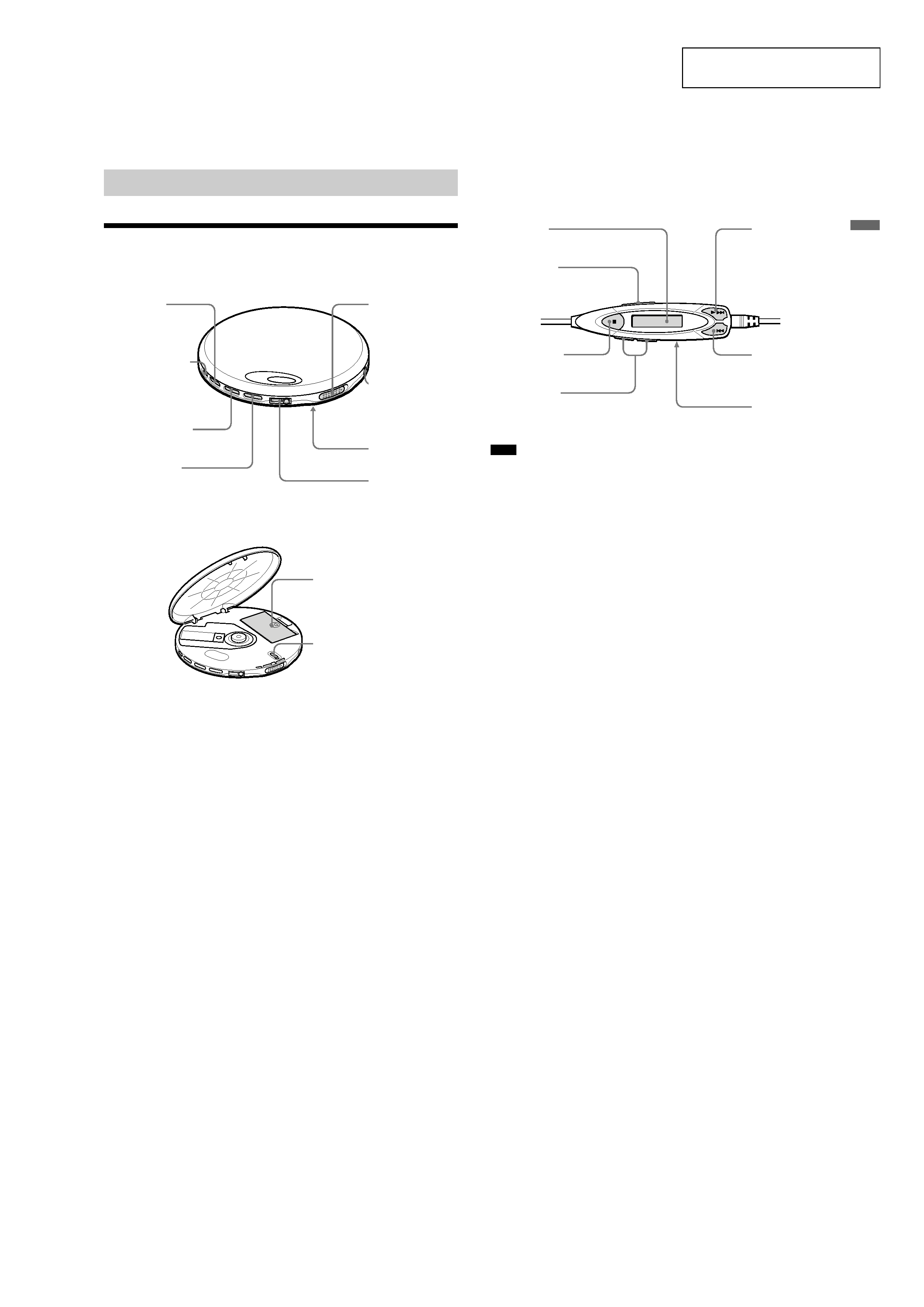
SERVICE MANUAL
Ver 1.2 2002.09
SPECIFICATIONS
PORTABLE CD PLAYER
D-EJ775
Canadian Model
AEP Model
UK Model
E Model
Australian Model
Chinese Model
Tourist Model
Model Name Using Similar Mechanism
D-EJ955
CD Mechanism Type
CDM-3325ES
Optical Pick-up Name
DAX-25E
System
Compact disc digital audio system
Laser diode proper ties
Material: GaAlAs
Wavelength:
= 780 nm
Emission duration: Continuous
Laser output: Less than 44.6
µW
(This output is the v alue measured at a distance
of 200 mm from the objecti ve lens surface on
the optical pick-up block with 7 mm aperture.)
D-A conversion
1-bit quartz time-axis control
Frequency response
40 - 20 000 Hz
+1
5 dB (measured by JEITA CP-
307)
Output (at 4.5 V input level)
Headphones
(stereo minijack)
Approx. 5 mW + Approx. 5 mW at 16
(Approx. 0.5 mW + Approx. 0.5 mW a t 16
)*
*For the customer s in France
Power requirements
For the ar ea code of the model you
purchased, check the upper left side of the
bar code on the package.
·Two Son y NC-WMAA rechargeable
batteries: 2.4 V DC
· Sony NH-WM2AA rechargeable batteries:
2.4 V DC
·Two LR6 (size AA) batteries: 3 V DC
·AC power ada ptor (DC IN 4.5 V jac k):
Canadian and Taiwan models:
120 V, 60 Hz
AEP and E13 models:
220 - 230 V, 50/60 Hz
UK model: 230 - 240 V, 50 Hz
Australian model: 240 V, 50 Hz
Tourist, E33 and Korean models: 100 - 240 V,
50/60 Hz
Hong Kong model: 220 V, 50/60 Hz
Chinese model: 220 V, 50 Hz
Battery life* (approx. hours)
(When you use the CD player on a flat and stable
surface.)
Playing time va ries de pending on how the CD
player is used.
When using
G-PROTECTION function
on
off
Two NC-WMAA
12
8
(charged for
about 3 hours**)
NH-WM2AA
22
17
(charged for
about 5 hours**)
Two Sony alkaline
41
29
batteries LR6(SG)
(produced in Japan)
* Measured value by the standard of JEITA (Japan
Electronics and Information Te chnology
Industries Association).
** Charging time va ries depending on how the
re chargeable battery is used.
Operating temperature
5
°C - 35°C (41°F - 95°F)
Dimensions (w/h/d) (excluding
projecting parts and controls)
Approx. 136.0
× 19.8 × 136.0 mm
(5 3/8
× 25/32 × 5 3/8 in.)
Mass (excluding accessories)
Approx. 160 g (5.7 oz.)
Design and specif ications ar e subject to chang e
without notice.
· Abbreviation
E13: 220 - 230 V AC area in E model
E33: 100 - 240 V AC area in E model
Supplied accessories
For the area code of the location in which you
purchased the CD player, check the upper left side
of the bar code on the package.
AC power adaptor (1)
Headphones/earphones with remote control (1)
Rechargeable batteries (2)
Battery carrying case (1)
AC plug adaptor (1)*1
*1
Supplied with Tourist and E33 models
9-873-592-03
Sony Corporation
2002I0500-1
Personal Audio Company
C
2002.09
Published by Sony Engineering Corporation

2
D-EJ775
Notes on chip component replacement
·Never reuse a disconnected chip component.
· Notice that the minus side of a tantalum capacitor may be dam-
aged by heat.
Flexible Circuit Board Repairing
·Keep the temperature of the soldering iron around 270 °C dur-
ing repairing.
· Do not touch the soldering iron on the same conductor of the
circuit board (within 3 times).
· Be careful not to apply force on the conductor when soldering
or unsoldering.
SAFETY-RELATED COMPONENT WARNING!!
COMPONENTS IDENTIFIED BY MARK 0 OR DOTTED
LINE WITH MARK 0 ON THE SCHEMATIC DIAGRAMS
AND IN THE PARTS LIST ARE CRITICAL TO SAFE
OPERATION. REPLACE THESE COMPONENTS WITH
SONY PARTS WHOSE PART NUMBERS APPEAR AS
SHOWN IN THIS MANUAL OR IN SUPPLEMENTS PUB-
LISHED BY SONY.
TABLE OF CONTENTS
1.
SERVICING NOTES ............................................... 3
2.
GENERAL ................................................................... 5
3.
DISASSEMBLY
3-1. Disassembly Flow ...........................................................
6
3-2. Lid Upper Sub Assy ........................................................
6
3-3. Plate (Spring) ..................................................................
7
3-4. Cabinet (Upper) Sub Assy ..............................................
7
3-5. Main Board, Optical Pick-up Section
(CDM-3325ES) ...............................................................
8
4.
ELECTRICAL ADJUSTMENTS ......................... 9
5.
DIAGRAMS
5-1. Block Diagram Servo Section ................................. 11
5-2. Block Diagram AUDIO/KEY CONTROL/
POWER SUPPLY Section ........................................... 12
5-3. Note for Printed Wiring Boards and
Schematic Diagrams ....................................................... 13
5-4. Printed Wiring Boards MAIN (Component Side)
(Suffix-11)/SUB Boards .............................................. 14
5-5. Printed Wiring Board MAIN Board
(Conductor Side) (Suffix-11) ....................................... 15
5-6. Schematic Diagram MAIN (1/3)
(Suffix-11)/SUB Boards .............................................. 16
5-7. Schematic Diagram MAIN Board (2/3)
(Suffix-11) .................................................................... 17
5-8. Schematic Diagram MAIN Board (3/3)
(Suffix-11) .................................................................... 18
5-9. Schematic Diagram MAIN Board (1/3)
(Suffix-12)/SUB Boards .............................................. 19
5-10. Schematic Diagram MAIN Board (2/3)
(Suffix-12) ................................................................... 20
5-11. Schematic Diagram MAIN Board (3/3)
(Suffix-12) ................................................................... 21
5-12. Printed Wiring Boards MAIN (Component Side)
(Suffix-12)/SUB Boards .............................................. 22
5-13. Printed Wiring Board MAIN Board
(Conductor Side) (Suffix-12) ....................................... 23
5-14. Printed Wiring Board MAIN Board
(Component Side) (Suffix-13) ..................................... 24
5-15. Printed Wiring Board MAIN Board
(Conductor Side) (Suffix-13) ....................................... 25
5-16. Schematic Diagram MAIN Board (1/3)
(Suffix-13) .................................................................... 26
5-17. Schematic Diagram MAIN Board (2/3)
(Suffix-13) .................................................................... 27
5-18. Schematic Diagram MAIN Board (3/3)
(Suffix-13) .................................................................... 28
5-19. IC Pin Function Description ........................................... 30
6.
EXPLODED VIEWS
6-1. Cabinet Section ............................................................... 32
6-2. Main Section ................................................................... 33
6-3. Optical Pick-up Section (CDM-3325ES) ....................... 34
7.
ELECTRICAL PARTS LIST ............................... 35
This appliance is classified as a CLASS 1 LASER product.
The CLASS 1 LASER PRODUCT MARKING is located on
the rear exterior.
CAUTION
Use of controls or adjustments or performance of procedures
other than those specified herein may result in hazardous ra-
diation exposure.
On AC poweradaptor
·Use only the AC power adaptor supplied or
recommended in "Accessories (supplied/
optional)." Do not use any other AC power
adaptor. It may cause a malfunction.
Polarity of the plug
ATTENTION AU COMPOSANT AYANT RAPPORT
À LA SÉCURITÉ!
LES COMPOSANTS IDENTIFIÉS PAR UNE MARQUE 0
SUR LES DIAGRAMMES SCHÉMATIQUES ET LA LISTE
DES PIÈCES SONT CRITIQUES POUR LA SÉCURITÉ
DE FONCTIONNEMENT. NE REMPLACER CES COM-
POSANTS QUE PAR DES PIÈCES SONY DONT LES
NUMÉROS SONT DONNÉS DANS CE MANUEL OU
DANS LES SUPPLÉMENTS PUBLIÉS PAR SONY.

3
D-EJ775
SECTION 1
SERVICING NOTES
The laser diode in the optical pick-up block may suffer electro-
static breakdown because of the potential difference generated by
the charged electrostatic load, etc. on clothing and the human body.
During repair, pay attention to electrostatic breakdown and also
use the procedure in the printed matter which is included in the
repair parts.
The flexible board is easily damaged and should be handled with
care.
NOTES ON LASER DIODE EMISSION CHECK
The laser beam on this model is concentrated so as to be focused
on the disc reflective surface by the objective lens in the optical
pick-up block. Therefore, when checking the laser diode emis-
sion, observe from more than 30 cm away from the objective lens.
BEFORE REPLACING THE OPTICAL PICK-UP BLOCK
Please be sure to check thoroughly the parameters as par the "Op-
tical Pick-Up Block Checking Procedures" (Part No.: 9-960-027-
11) issued separately before replacing the optical pick-up block.
Note and specifications required to check are given below.
· FOK output: IC601 yg pin
When checking FOK, remove the lead wire to disc motor.
· RF signal P-to-P value: 0.4 to 1 Vp-p
LASER DIODE AND FOCUS SEARCH OPERATION
CHECK
During normal operation of the equipment, emission of the laser
diode is prohibited unless the upper lid is closed while turning ON
the S801. (push switch type)
The following checking method for the laser diode is operable.
· Method:
Emission of the laser diode is visually checked.
1. Open the upper lid.
2. With a disc not set, turn on the S801 with a screwdriver having
a thin tip as shown in Fig.1.
3. Press the > N key.
4. Observing the objective lens, check that the laser diode emits
light.
When the laser diode does not emit light, automatic power
control circuit or optical pickup is faulty.
In this operation, the objective lens will move up and down 5
times along with inward motion for the focus search.
NOTES ON HANDLING THE OPTICAL PICK-UP
BLOCK OR BASE UNIT
Fig. 1 Method to push the S804
S801
detection lever
detection lever
MAIN board
ABOUT CD-Rs/CD-RWs
This CD player can play CD-Rs/CD-RWs recorded in the CD-DA
format*, but playback capability may vary depending on the qual-
ity of the disc and the condition of the recording device.
* CD-DA is the abbreviation for Compact Disc Digital Audio. It is
a recording standard used for the Audio CDs.
MAIN BOARD IDENTIFICATION
MAIN Board (Component Side)
SUB Board
(MAIN Board suffix-11, -12 only)
1-683-934-11
1-683-934-12
1-683-934-13
MAIN Board (Conductor Side)

4
D-EJ775
SERVICE MODE
In the Service mode, this set can check the following.
1. Service Mode Setting Method
To set the service mode, perform as follows.
1) Make sure that the power is not turned on.
2) Check for the following states:
[HOLD] switch (S802) .......................... OFF
[SOUND] switch (S808) ....................... OFF
[G PROTECTION] switch (S803) ....... ON
3) Short the solder bridge at the TAP801 (TEST) and TAP802
(OPEN) on the MAIN board (see Fig. 2).
4) Turn the power on.
2. Operation in Service Mode
When the Service mode is set, the LCD on the remote commander
displays the microcomputer version display.
3. Operation of Buttons in Service Mode
The following operation can be checked by operating the buttons
on the set and remote commander.
· N> / . keys on the set or remote commander
Tracking/sled servo off
Focus search Spindle servo on
Note: Do not look directly at the laser beam from the optical pick-up.
· [VOL +] / [VOL --] keys on the set or remote commander
Tracking servo off
Optical pick-up movement (outward or inward)
Note: Do not move forcibly the optical pick-up exceeding the most-out-
side or most-inside track.
·
x
key on the set or remote commander
All servos (focus/tracking/sled) off
· [MENU] key on the set
Spindle speed change
Tracking/sled servo on
· [SOUND] key on the sed
Servo auto adjustment
4. Service Mode Releasing Method
To release the service mode, perform as follows.
1) Turn the power off.
2) Open the solder bridge at the TAP801 (TEST) and TAP802
(OPEN) on the MAIN board.
Note: Remove the solder completely.
MAIN Board (Component Side)
Fig. 2
TAP801 (TEST)
TAP802 (OPEN)
·
00 0052
R
microcomputer version

5
D-EJ775
SECTION 2
GENERAL
This section is extracted from
instruction manual.
Getting started
Locating the controls
For details, see pages in parentheses.
CD player (front)
CD player (inside)
8 i
(headphones)
jack
9
Battery compartment
7
HOLD switch
5
OPEN switch
6
DC IN 4.5 V (e xternal
power input) jack
2
CHARGE/x (stop)
button·CHARGE
lamp
0
G-PR OTECTION
switch
3
VOL (volume) +*/
button
1
. (AMS/
search)·> (AMS/
search) N* (play)
button
*The button has a tactile dot.
4
SOUND·MENU
button
Remote control
Note
Use only the supplied remote control. You cannot operate this CD player with the remote control supplied with
other CD players.
Getting
started
qs
HOLD switch
(rear)
qg
N (play)>
(AMS/sear ch) button
qd
x (stop) b utton
qh
.(AMS/search)
button
qf
VOL (volume)
+/ buttons
qa
Display
qj
Clip
